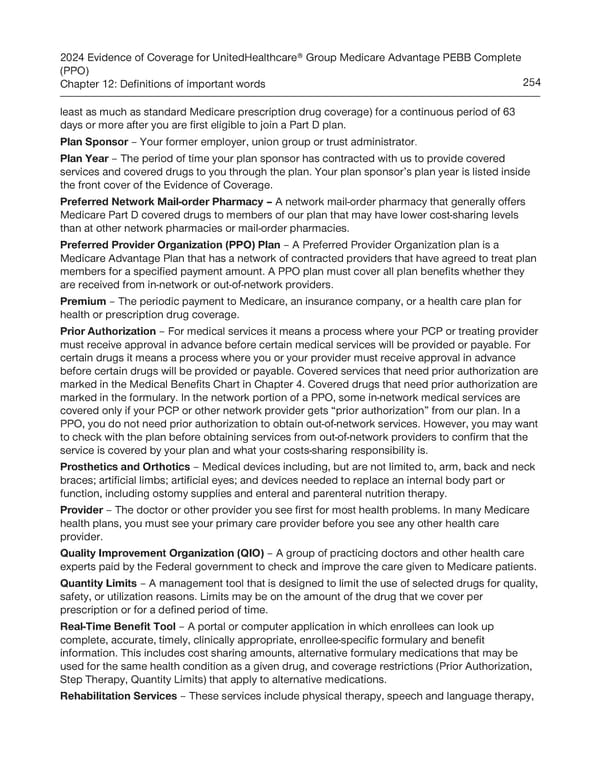2024 Evidence of Coverage for UnitedHealthcare® Group Medicare Advantage PEBB Complete (PPO) Chapter 12: Definitions of important words 254 least as much as standard Medicare prescription drug coverage) for a continuous period of 63 days or more after you are first eligible to join a Part D plan. Plan Sponsor – Your former employer, union group or trust administrator. Plan Year – The period of time your plan sponsor has contracted with us to provide covered services and covered drugs to you through the plan. Your plan sponsor’s plan year is listed inside the front cover of the Evidence of Coverage. Preferred Network Mail-order Pharmacy – A network mail-order pharmacy that generally offers Medicare Part D covered drugs to members of our plan that may have lower cost-sharing levels than at other network pharmacies or mail-order pharmacies. Preferred Provider Organization (PPO) Plan – A Preferred Provider Organization plan is a Medicare Advantage Plan that has a network of contracted providers that have agreed to treat plan members for a specified payment amount. A PPO plan must cover all plan benefits whether they are received from in-network or out-of-network providers. Premium – The periodic payment to Medicare, an insurance company, or a health care plan for health or prescription drug coverage. Prior Authorization – For medical services it means a process where your PCP or treating provider must receive approval in advance before certain medical services will be provided or payable. For certain drugs it means a process where you or your provider must receive approval in advance before certain drugs will be provided or payable. Covered services that need prior authorization are marked in the Medical Benefits Chart in Chapter 4. Covered drugs that need prior authorization are marked in the formulary. In the network portion of a PPO, some in-network medical services are covered only if your PCP or other network provider gets “prior authorization” from our plan. In a PPO, you do not need prior authorization to obtain out-of-network services. However, you may want to check with the plan before obtaining services from out-of-network providers to confirm that the service is covered by your plan and what your costs-sharing responsibility is. Prosthetics and Orthotics – Medical devices including, but are not limited to, arm, back and neck braces; artificial limbs; artificial eyes; and devices needed to replace an internal body part or function, including ostomy supplies and enteral and parenteral nutrition therapy. Provider – The doctor or other provider you see first for most health problems. In many Medicare health plans, you must see your primary care provider before you see any other health care provider. Quality Improvement Organization (QIO) – A group of practicing doctors and other health care experts paid by the Federal government to check and improve the care given to Medicare patients. Quantity Limits – A management tool that is designed to limit the use of selected drugs for quality, safety, or utilization reasons. Limits may be on the amount of the drug that we cover per prescription or for a defined period of time. Real-Time Benefit Tool – A portal or computer application in which enrollees can look up complete, accurate, timely, clinically appropriate, enrollee-specific formulary and benefit information. This includes cost sharing amounts, alternative formulary medications that may be used for the same health condition as a given drug, and coverage restrictions (Prior Authorization, Step Therapy, Quantity Limits) that apply to alternative medications. Rehabilitation Services – These services include physical therapy, speech and language therapy,
 UnitedHealthcare PEBB Complete EOC (2024) Page 259 Page 261
UnitedHealthcare PEBB Complete EOC (2024) Page 259 Page 261